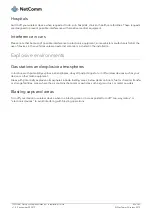
IFWA-661 Outdoor Wireless Antenna
–
Installation Guide
59 of 63
v1.0 September 20, 2019
© NetComm Wireless 2019
Safety and product care
RF Exposure
Your device contains a transmitter and a receiver. When it is on, it receives and transmits RF energy. When you
communicate with your device, the system handling your connection controls the power level at which your device
transmits.
This device meets the government’s requirements for exposure to radio waves.
This device is designed and manufactured not to exceed the emission limits for exposure to radio frequency (RF)
energy set by the Federal Communications Commission of the U.S. Government.
This equipment complies with radio frequency (RF) exposure limits adopted by the Federal Communications
Commission for an uncontrolled environment. This equipment should be installed and operated with minimum
distance 1 foot between the radiator & your body.
FCC Statement
This device must be professionally installed. This device must be installed 20m removed from roadway or installed
in locations where it can be shown that the ground power level of −44 dBm in the A or B blocks or −55 dBm in the
C or D blocks will not be exceeded at the nearest road location.
FCC compliance
Federal Communications Commission Notice (United States): Before a wireless device model is available for sale to
the public, it must be tested and certified to the FCC that it does not exceed the limit established by the
government-adopted requirement for safe exposure.
FCC regulations
This device complies with part 15 of the FCC Rules. Operation is subject to the following two conditions: (1) This
device may not cause harmful interference, and (2) this device must accept any interference received, including
interference that may cause undesired operation.
This device has been tested and found to comply with the limits for a Class B digital device, pursuant to Part 15 of
the FCC Rules. These limits are designed to provide reasonable protection against harmful interference in a
residential installation. This equipment generates, uses and can radiate radio frequency energy and, if not installed
and used in accordance with the instructions, may cause harmful interference to radio communications. However,
there is no guarantee that interference will not occur in a particular installation. If this equipment does cause
harmful interference to radio or television reception, which can be determined by turning the equipment off and
on, the user is encouraged to try to correct the interference by one or more of the following measures:
Reorient or relocate the receiving antenna.
Increase the separation between the equipment and receiver.
Connect the equipment into an outlet on a circuit different from that to which the receiver is connected.
Consult the dealer or an experienced radio/TV technician for help.
Changes or modifications not expressly approved by the party responsible for compliance could void the user‘s
authority to operate the equipment.





































